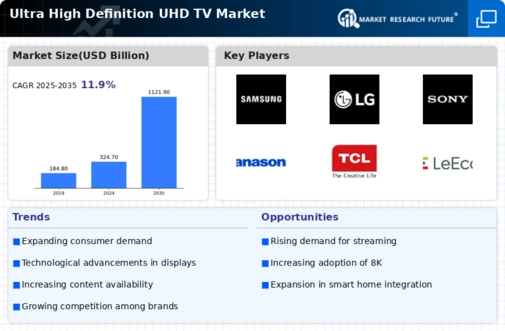Market Growth Projections
The Global Ultra High Definition UHD TV Market Industry is projected to experience substantial growth over the coming years. With a market valuation of 324.7 USD Billion in 2024, the industry is expected to expand significantly, reaching an estimated 1121.9 USD Billion by 2035. This growth trajectory suggests a compound annual growth rate of 11.93% from 2025 to 2035. Factors contributing to this growth include rising consumer demand for high-quality content, technological advancements, and the increasing adoption of smart TVs. As the market evolves, it is likely to attract new players and innovations, further enhancing the competitive landscape.
Expansion of 5G Technology
The expansion of 5G technology is poised to have a transformative impact on the Global Ultra High Definition UHD TV Market Industry. With its high-speed internet capabilities, 5G enables seamless streaming of UHD content, reducing buffering times and enhancing overall user experience. As consumers increasingly adopt 5G-enabled devices, the demand for UHD TVs that can leverage this technology is likely to rise. This trend is expected to support the market's growth, with projections indicating a compound annual growth rate of 11.93% from 2025 to 2035. The synergy between 5G technology and UHD TVs could redefine home entertainment, making high-quality content more accessible than ever.
Increasing Adoption of Smart TVs
The increasing adoption of smart TVs plays a pivotal role in shaping the Global Ultra High Definition UHD TV Market Industry. Smart TVs, equipped with internet connectivity and built-in applications, offer consumers a seamless integration of entertainment options. This trend aligns with the growing preference for on-demand content and personalized viewing experiences. As of 2024, the market reflects a valuation of 324.7 USD Billion, driven by the demand for smart features in UHD TVs. Furthermore, the integration of voice control and smart home compatibility enhances user engagement, suggesting that the smart TV segment will continue to thrive, potentially propelling the market to new heights.
Growing Interest in Gaming and Esports
The growing interest in gaming and esports significantly influences the Global Ultra High Definition UHD TV Market Industry. Gamers increasingly seek high-resolution displays that enhance their gaming experience, making UHD TVs an attractive option. The rise of competitive gaming and streaming platforms has further fueled this demand, as gamers desire the best visual quality for immersive gameplay. In 2024, the market is valued at 324.7 USD Billion, reflecting this trend. As gaming technology continues to advance, the need for UHD TVs that support high refresh rates and low latency is likely to drive market growth, indicating a promising future for UHD TV adoption in the gaming sector.
Rising Consumer Demand for High-Quality Content
The Global Ultra High Definition UHD TV Market Industry experiences a notable surge in consumer demand for high-quality content, driven by the proliferation of streaming services and digital media. As consumers increasingly seek immersive viewing experiences, UHD TVs, with their superior resolution and color accuracy, become essential. In 2024, the market is valued at 324.7 USD Billion, reflecting this growing preference. Major platforms such as Netflix and Amazon Prime Video are expanding their UHD content libraries, further fueling this trend. This shift towards high-quality content consumption is likely to sustain the industry's growth trajectory, indicating a robust future for UHD TV adoption.
Technological Advancements in Display Technology
Technological advancements in display technology significantly influence the Global Ultra High Definition UHD TV Market Industry. Innovations such as OLED and QLED technologies enhance picture quality, offering deeper blacks and vibrant colors. These advancements not only improve the viewing experience but also attract consumers seeking the latest in home entertainment technology. As manufacturers invest in research and development, the introduction of new features, such as HDR and wide color gamut, becomes commonplace. This continuous evolution in display technology is expected to contribute to the market's expansion, with projections indicating a market size of 1121.9 USD Billion by 2035, showcasing the potential for sustained growth.




















